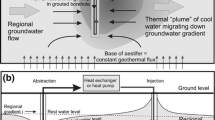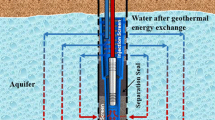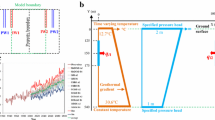Abstract
Groundwater can serve as an environmentally friendly and renewable energy source when utilized in a groundwater heat pump system. Installation of such systems has been increasing worldwide in recent years. Performance of a groundwater heat pump system depends on local hydrogeological and thermo geological conditions. It is important that aquifer properties be determined to be representative of the site when designing a system in order to maximize efficiency, reduce installation costs, and minimize any environmental impacts. Factors that need to be considered are the groundwater temperature profile to the depth at which the temperature becomes relatively stable; hydraulic and thermal conductivities; diffusivity of the soil and rock layers; groundwater levels; and groundwater quality. Selection of groundwater and heat pump coupling techniques relies on, to a large extent, an accurate conceptual site scale model of groundwater conditions and understanding of environmental and legal constraints.




Similar content being viewed by others
References
Andrews CB (1978) The impact of the use of heat pumps on ground water temperatures. Ground Water 16(6):437
Armitage DM, Bacon DJ, Massey-Norton JT, Miller JM (1980) Groundwater heat pumps: an examination of hydrogeologic, environmental, legal and economic factors affecting their use. Department of Energy Report DOE/CS/20060-5120, vol 1
Banks (2008) An Introduction to thermogeology: ground source heating and cooling. Blackwell Publishing, Oxford
Bouwer H (1977) Land subsidence and cracking due to ground-water depletions. Ground Water 15(5):358–364
Busby J, Lewis M, Reeves H, Lawley R (2009) Initial geological considerations before installing ground source heat pump systems. Q J Eng GeolHydrogeol 42(3):295–306
Chiasson AC, Rees SJ, Spitler JD (2000) A preliminary assessment of the effects of ground-water flow on closed-loop ground-source heat pump systems. ASHRAE Trans 106(1):380–393
Dochartaigh BEO (2009) A scoping study into shallow thermogeological resources beneath Glasgow and the surrounding area. British Geological Survey Internal Report, IR/09/024, p 21
Domenico PA, Schwartz FW (1990) Physical and chemical hydrogeology. Wiley, New York
Gehlin S (2002) Thermal response test: method development and evaluation. Doctoral thesis of Lulea University of Technology
Heath RC (1983) Basic ground-water hydrology. US Geological Survey Water Supply Paper 2220
Hellstrom G (1991) Ground heat storage. Thermal Analyses of duct storage systems. University of Lund, Department of Mathematical Physics, Lund
Hughes PJ (2008) Geothermal (ground-source) heat pumps: market status, barriers to adoption, and actions to overcome barriers. Oak Rridge National Laboratory Report ORNL/TM-2008/232
Lo Russo S, Civita MV (2009) Open-loop groundwater heat pumps development for large buildings: a case study. Geothermics 38(3):335–345
Ni L, Jiang YQ, Yao Y, Ma ZL (2006) Groundwater heat pump with pumping and recharging in the same well in China. In: Proceedings of the sixth international conference for enhanced building operations, Shenzhen, China, November 6–9, 2006. Renewable energy resources and a greener future, vol. VIII-10-4
Orio CD, Johnson CN, Rees SJ, Chiasson A, Deng Z, Spitler JD (2005) A survey of standing column well installations in North America. ASHRAE Trans 111(2):109–121
Rybach L, Sanner B (2000) Ground source heat pump systems, the European experience. GHC Bull 21:16–26
Sanner B, Karytsasb C, Mendrinosb D, Rybach L (2003) Current status of ground source heat pumps and underground thermal energy storage in Europe. Geothermics 32(2003):579–588
Sanner B, Hellström G, Spitler J, Gehlin S (2005) Thermal response test—current status and world-wide application. In: Proceedings World Geothermal Congress 2005 Antalya, Turkey, 24–29 April 2005
Sasman RT (1972) Thermal pollution of ground water by artificial recharge. Water Sewage Works 119(12):52–55
USEPA (1999) The class V underground injection control study: heat pump and air conditioning return flow wells, EPA/816-R-99-014s, vol 19. Office of Ground Water and Drinking Water, United States Environmental Protection Agency
Werner D, Kley W (1977) Problems of heat storage in aquifers. J Hydrol 34(1/2):35–43
Xu S, Rybach L (2005) Development and application of a new, powerful groundwater heat pump system for space heating and cooling. In: Proceedings World Geothermal Congress, Antalya, Turkey
Zhou W, Beck BF (2011) Engineering issues on Karst. In: van Beynen PE (ed) Karst management. Springer, Berlin
Acknowledgments
This research was financially supported by China National Scientific and Technical Support Program (Grant Nos. 2012BAB12B03-03 and 201105060-06), China National Natural Science Foundation (Grant Nos. 51174289 and 41102180), Innovation Research Team Program of Ministry of Education (IRT1085), National Geological Survey Program (shui[2012]-01-035-036), Fundamental Research Funds for the Central Universities (2010YD 02) and State Key Laboratory of Coal Resources and Safe Mining.
Author information
Authors and Affiliations
Corresponding author
Rights and permissions
About this article
Cite this article
Wu, Q., Xu, S., Zhou, W. et al. Hydrogeology and design of groundwater heat pump systems. Environ Earth Sci 73, 3683–3695 (2015). https://doi.org/10.1007/s12665-014-3654-2
Received:
Accepted:
Published:
Issue Date:
DOI: https://doi.org/10.1007/s12665-014-3654-2




